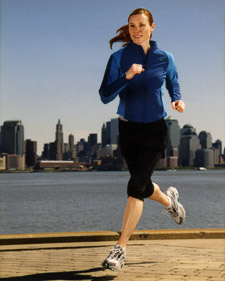How to Select Athletic Shoes

Too many people choose fashion over function when purchasing athletic shoes, not realizing that poor-fitting shoes can lead to pain throughout the body. Because footwear plays such an important role in the function of bones and joints—especially for runners and other athletes—choosing the right shoe can help prevent pain in your back, hips, knees, and feet.
Unfortunately, there is no such thing as the very best athletic shoe—every pair of feet is different, every shoe has different features, and overall comfort is a very personal decision. For this reason, it is recommended that you first determine your foot type: normal, flat, or high-arched.
The Normal Foot:
Normal feet have a normal-sized arch and will leave a wet footprint that has a flare, but shows the forefoot and heel connected by a broad band. A normal foot lands on the outside of the heel and rolls slightly inward to absorb shock.
Best shoes: Stability shoes with a slightly curved shape.
The Flat Foot:
This type of foot has a low arch and leaves a print that looks like the whole sole of the foot. It usually indicates an over-pronated foot—one that strikes on the outside of the heel and rolls excessively inward (pronates). Over time, this can cause overuse injuries.
Best shoes: Motion-control shoes or high-stability shoes with firm midsoles. These shoes should be fairly resistant to twisting or bending. Stay away from highly cushioned, highly curved shoes, which lack stability features.
The High-Arched Foot:
The high-arched foot leaves a print showing a very narrow band—or no band at all—between the forefoot and the heel. A curved, highly arched foot is generally supinated or under-pronated. Because the foot doesn’t pronate enough, usually it’s not an effective shock absorber.
Best shoes: Cushioned shoes with plenty of flexibility to encourage foot motion. Stay away from motion-control or stability shoes, which reduce foot mobility.
When determining your foot type, consult with your doctor of chiropractic. He or she can help determine your specific foot type, assess your gait, and then suggest the best shoe match.
Consider the following tips before you purchase your next pair of athletic shoes:
• Match the shoe to the activity. Select a shoe specific for the sport in which you will participate. Running shoes are primarily made to absorb shock as the heel strikes the ground. In contrast, tennis shoes provide more side-to-side stability. Walking shoes allow the foot to roll and push off naturally during walking, and they usually have a fairly rigid arch, a well-cushioned sole, and a stiff heel support for stability.
• If possible, shop at a specialty store. It’s best to shop at a store that specializes in athletic shoes. Employees at these stores are often trained to recommend a shoe that best matches your foot type (shown above) and stride pattern.
• Shop late in the day. If possible, shop for shoes at the end of the day or after a workout when your feet are generally at their largest. Wear the type of socks you usually wear during exercise, and if you use orthotic devices for postural support, make sure you wear them when trying on shoes.
• Have your feet measured every time. It’s important to have the length and width of both feet measured every time you shop for shoes, since foot size often changes with age and most people have 1 foot that is larger than the other. Also, many podiatrists suggest that you measure your foot while standing in a weight bearing position because the foot elongates and flattens when you stand, affecting the measurement and the fit of the shoe.
• Make sure the shoe fits correctly. Choose shoes for their fit, not by the size you’ve worn in the past. The shoe should fit with an index finger’s width between the end of the shoe and the longest toe. The toe box should have adequate room and not feel tight. The heel of your foot should fit snugly against the back of the shoe without sliding up or down as you walk or run. If possible, keep the shoe on for 10 minutes to make sure it remains comfortable.
How Long Do Shoes Last?
Once you have purchased a pair of athletic shoes, don’t run them into the ground. While estimates vary as to when the best time to replace old shoes is, most experts agree that between 300 and 500 miles is optimal. In fact, most shoes should be replaced even before they begin to show signs of moderate wear. Once shoes show wear, especially in the cushioning layer called the midsole, they also begin to lose their shock absorption. Failure to replace worn shoes is a common cause of injuries like shin splints, heel spurs, and plantar fasciitis.









.JPG)





1 comment:
Good content. Just wanted to add some buying advice for those on a budget.
There is a huge market for sports shoes but what’s significant is the genuineness of the shoes we intend to buy. Most often we think that a pair of authentic shoes would cost us big money and so we turn to fake shoes which are available at very low prices not realizing the consequences of wearing them in the long run.
However, you will be happy to know that you can still get genuine sports shoes at cheap prices. The only thing that we require is a little bit of research to know which stores stock original stuff and offer good discounts that make genuine shoes affordable and fit our budget. So spend sometime and research online to find where you can shop around, how you can shop and when is the best time to shop.
Post a Comment